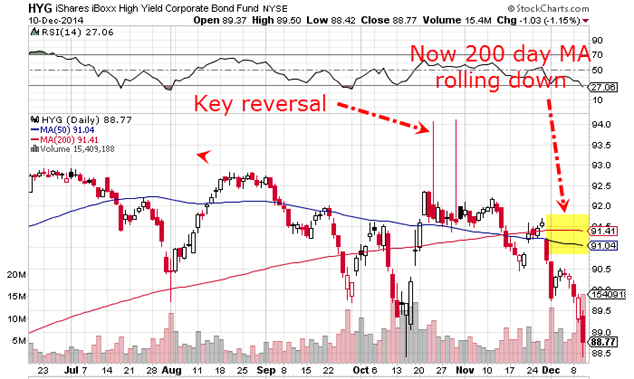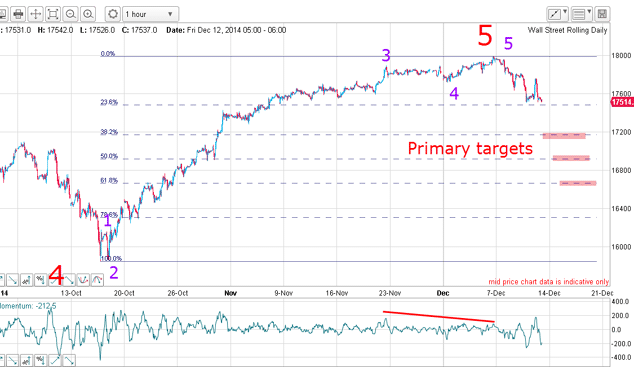This isn’t a Santa rally – it’s the start of a major deflationary wave
The stockmarket bulls are expecting a Santa rally. But the market seems to have other ideas, says John C Burford. Equities are joining in the deflationary plunge.
Finally, after all that agonised waiting on my part, stocks got the message. And that means we are about to endure a very severe deflationary depression fuelled by a collapse in the debt and commodity markets.
I have been forecasting this outcome for the global economy for many months. We have only just started the process in this final month of the year. It should become much more severe next year.
Until very recently, my deflationary view was considered by the vast majority as so far off the wall that it wasn't even a blip on the radar of rationality (if I can mix my metaphors).
MoneyWeek
Subscribe to MoneyWeek today and get your first six magazine issues absolutely FREE

Sign up to Money Morning
Don't miss the latest investment and personal finances news, market analysis, plus money-saving tips with our free twice-daily newsletter
Don't miss the latest investment and personal finances news, market analysis, plus money-saving tips with our free twice-daily newsletter
I confess I did get a few sideways glances whenever I spoke of it earlier. And when I suggested getting into cash, they started calling for the straitjacket.
This is what I wrote last Friday: "Now that every man, woman, child and their dogs (and cats) are bullish on stocks and believe they can never fall courtesy of the Fed and that we are about to enter the sunny uplands of 2015, my mind is turning to thoughts of a historic reversal. One that will shock most people in its severity".
So today I want to tell you more about why I believe we are on the verge of a historic reversal.
Black swans do exist
If ever there was a case to be brought for product misrepresentation, this was it. The company was neither long term (it blew up within four years) and it mis-managed clients' capital. But almost no one forecast its rapid demise before it happened, of course. After all, it was making profits of around 20% a year in its first three years. Who has the temerity to call tops under this scenario?
The basic idea behind LTCM was that the financial markets are entirely rational and if they could exploit the small mis-alignments between different but related markets, they could rely on these small deviations to correct in time, and then they could take their profits.
But a small problem arose the irrational' deviations between markets got wider and wider, not narrower, and eventually they became so wide that the Fed was forced to bail it out. That little operation gave meaning to the term too big to fail'. It also popularised the term black swan event'. But as we all know, black swans do exist down under (let that be a lesson to those that say stocks can never fall). The impossible can happen.
The point I want to make is that markets are not rational and especially today when Zirp (zero interest rate policy) and QE (quantitative easing) dominate. Under this scenario, mis-investments proliferate as greed is allowed to get the upper hand with free money at its disposal. But eventually, market forces intrude to spoil the party. That is when we see major turns and the bubbles burst often spectacularly. Markets are then forced to become more rational.
So, is it different this time in this world of Zirp as so many believe? We are about to find out.
What my plunge-ometer tells us
Here is the bellwether junk bond index aka my plunge-ometer:

We had the death cross' in mid November and the spike key reversals in late October. Now the closely-watched 200-day moveing average (MA) has rolled over, with trading volumes higher on the declines. This is a killer combination, and spells big trouble for this market. This is occurring despite Treasury yields falling. Mind the (widening) gap!
Also, one by one, asset markets are falling off their highs and are now in long-term downtrends. Here are some major industrial and financial markets:
- Gold (topped at $1922, now $1200) and silver - both topped in 2011
- Crude topped in 2008 at $145 (now $62)
- Iron ore topped in 2010 (at $190, now $80)
- Copper topped in 2011 (at $4.50, now $2.90)
- Coal topped in 2008 (at $140, now $50)
The deflationary wave is here
But quietly, under the surface, prices are falling. That is not because supply is being boosted, but that demand is weak and debts are sky-high. Here in the UK, the so-called German discounters' are grabbing great bites out of supermarket share at the expense of the big operators, who are being forced to drop prices to compete. This is reducing the nation's grocery bill a disinflationary effect.
The only hold-out in this deflationary scenario is the stock markets until this week. Equities have been pumped up by the waves of liquidity from QE as investors believe the Fed has their backs price collapses are impossible. After all, the Fed has its Plunge Protection Team! But that is exactly the kind of thinking that dominates at major tops.
This morning, France announced it has just entered this deflationary scenario with core consumer inflation negative for the first time since modern records began, and is destined to go even more negative. That is hugely significant, and a harbinger of things to come globally. Incidentally, I always believed the major deflationary wave would emanate from Europe (as in the 1920s), and here it is.
Cash is king in a deflationary scenario

My 3rd wave is very long and strong, as required, and the market has now fallen sharply off the 18,000 w5 high. I have marked my main targets with the major ones being the 50% and 62% levels.
Here are my Elliott waves on the decline:

The key test is to see a small-scale five down to confirm the top do I have one? Yes, indeed there is a lovely five down and then a terrific three up to yesterday's Fibonacci 50% correction. That was a terrific place to enter short trades, of course.
But we are in a large w3 down now and the ride should be exciting!
The FTSE is further down the escalator and has corrected its October December wave by more than 50% to this morning.
We are re-learning the old adage cash is king in a deflationary scenario.
Get the latest financial news, insights and expert analysis from our award-winning MoneyWeek team, to help you understand what really matters when it comes to your finances.
John is is a British-born lapsed PhD physicist, who previously worked for Nasa on the Mars exploration team. He is a former commodity trading advisor with the US Commodities Futures Trading Commission, and worked in a boutique futures house in California in the 1980s.
He was a partner in one of the first futures newsletter advisory services, based in Washington DC, specialising in pork bellies and currencies. John is primarily a chart-reading trader, having cut his trading teeth in the days before PCs.
As well as his work in the financial world, he has launched, run and sold several 'real' businesses producing 'real' products.
-
 Investors will reap long-term rewards from UK equities
Investors will reap long-term rewards from UK equitiesOpinion Nick Train, portfolio manager, Finsbury Growth & Income Trust, highlights three UK equities where he’d put his money
-
 The graphene revolution is progressing slowly but surely
The graphene revolution is progressing slowly but surelyEnthusiasts thought the discovery that graphene, a form of carbon, could be extracted from graphite would change the world. They might've been early, not wrong.